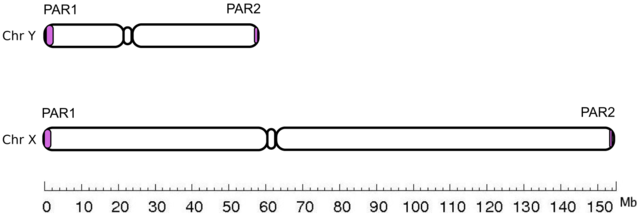Genetics of Sex
Objectives
- Define sex chromosome, autosome, heterogametic, homogametic, and haploinsufficient.
- Compare and contrast mechanisms of sex determination in different species.
- Recognize that both sex-linked and autosomal genes play a role in sex development in humans, and explain how disruptions in the sex development pathway can lead to differences of sex development.
- Distinguish between sex-determination, sex-linked, and sex-influenced genes
- Recognize that sex-linked traits show different inheritance patterns from autosomal traits
- Use a modified Punnett square to predict the inheritance of sex-linked traits.
- Explain what is meant by dosage compensation, and explain how X-inactivation can lead to codominance, incomplete dominance, or variable expressivity of X-linked traits.
Introduction to sex chromosomes: it’s not just X and Y
In the chapter on Genome Structure, we first introduced the difference between sex chromosomes and autosomes. Historically they were identified because they were easily visible under the microscope, and, depending on the species of organism being studied, these distinctive chromosomes tracked with sex through generations. Geneticists later found that these chromosomes carry genes associated with the development of sex structures, called sex-determination genes.
In humans and other mammals, males typically have one X and one Y chromosome and are said to be heterogametic. Females typically have two X chromosomes and are homogametic.
Note 1: In this text, you’ll see the XX genotype described as “typically” or “most commonly” associated with a female phenotype, and the XY genotype with males. The reason for the “typically” or “most commonly” description is that there are many exceptions to this both in humans and other organisms. For example, there are individuals with sex chromosome aneuploidies (SCAs), with only one X chromosome (described sometimes as XO) or more than two sex chromosomes (XXX, XXY, or XXXX, for example). There are also many individuals for whom their sex chromosome pair (XY or XX) does not align with either the appearance of sex-associated traits or gender.
Note 2: Although humans and many other species (including some plants[1]!) use X and Y sex chromosomes, other organisms use different systems of sex determination. Birds, for example, use Z and W sex chromosomes. In yet other species, sex can be determined by environmental conditions or even the ploidy of an organism. In honeybees, for example, males are typically haploid and females are diploid[2].
The X and Y chromosomes share similar DNA sequence at the ends
During meiosis I, the autosomes are paired with their homolog. For both autosomes and sex chromosomes, the pairing happens due to sequence similarities between the sister homologs. This is discussed in more detail in the chapter on meiosis and mitosis. This is possible, even when that “pairing” is between XY or ZW chromosomes because the very ends of the sex chromosomes contain homologous sequences. These are called pseudoautosomal (PAR) regions because both males and females have two copies of all the genes in those regions. The pseudoautosomal regions of the X and Y chromosomes are shown in Figure 1.[3]
During meiosis, chromosome pairs – including XX or XY pairs – are separated into different daughter cells. This results in haploid daughter cells. Each daughter cell ultimately contains one copy of each autosome and one sex chromosome. For mammals, eggs typically carry an X chromosome and sperm carry either an X or Y chromosome. For birds, eggs typically contain either a Z or a W chromosome, while all sperm contain a Z chromosome.

Media Attributions
- Pseudoautosomal-region © Image Source: Kelkar A, Thakur V, Ramaswamy R, Deobagkar D (2009) Characterisation of Inactivation Domains and Evolutionary Strata in Human X Chromosome through Markov Segmentation. PLoS ONE 4(11): e7885. is licensed under a CC0 (Creative Commons Zero) license
- Charlesworth, D. Plant sex determination and sex chromosomes. Heredity 88, 94–101 (2002). ↵
- Sex Determination in Honeybees | Learn Science at Scitable. http://www.nature.com/scitable/topicpage/sex-determination-in-honeybees-2591764. ↵
- Image Source: Kelkar A, Thakur V, Ramaswamy R, Deobagkar D (2009) Characterisation of Inactivation Domains and Evolutionary Strata in Human X Chromosome through Markov Segmentation. PLoS ONE 4(11): e7885. ↵

